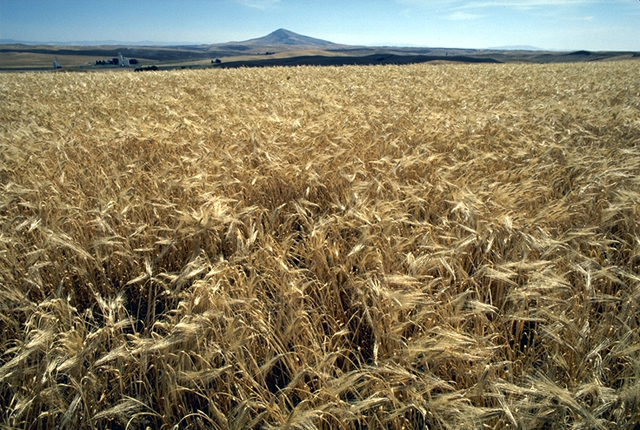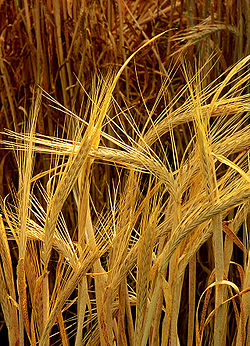This is an old revision of this page, as edited by Gene Nygaard (talk | contribs) at 13:10, 13 December 2004 (italic binomial names, round conversions better). The present address (URL) is a permanent link to this revision, which may differ significantly from the current revision.
Revision as of 13:10, 13 December 2004 by Gene Nygaard (talk | contribs) (italic binomial names, round conversions better)(diff) ← Previous revision | Latest revision (diff) | Newer revision → (diff)| Barley | ||||||||||||
|---|---|---|---|---|---|---|---|---|---|---|---|---|
 Barley field | ||||||||||||
| Scientific classification | ||||||||||||
| ||||||||||||
| Species | ||||||||||||
|
Hordeum arizonicum | ||||||||||||
| References | ||||||||||||
| ITIS 40865 2002-09-22 |
Barley (Hordeum vulgare) is a major food and animal feed crop, and a member of the grass family. Barley is the fifth largest cultivated cereal crop in the world (530,000 km² or 132 million acres). Its germination time is anywhere from 1-3 days.
Major barley producers are :
| Russia | 72,000 km² |
| Canada | 45,000 km² |
| Ukraine | 37,000 km² |
| Turkey | 36,000 km² |
| Spain | 33,000 km² |
| Australia | 30,000 km² |
| Morocco | 23,000 km² |
| USA | 21,000 km² |
| Iraq | 12,000 km² |
| Iran | 10,000 km² |
History
Cultivated barley is descended from wild barley (Hordeum spontaneum) which still can be found in the Middle East. Both forms are diploid (2n=14 chromosomes). All variants of barley produce viable seed when crossed and are thus considered to belong to one and the same species today. The major difference between wild and domesticated barley is the brittle rachis of the former, which is conductive to self-propagation. The earliest finds of barley come from Epi-Paleolithic sites the Levant, beginning in the Natufian. The first domesticated barley has been found in the aceramic neolithic layers (PPN B) of Tell Abu Hureyra in Syria. The domestication seems to be contemporaneous to that of wheat.
Barley, as an ancient and central gift of the earth, had ritual significance, probably from the earliest stages of the Eleusinian Mysteries. The preparatory kykeon or mixed drink of the initiates, prepared from barley and herbs, was referred to in the Homeric hymn to Demeter, who was also called "Barley-mother".
Greek practice was to dry the barley groats and roast them before preparing the porridge, according to Pliny's Natural History (xviii.72). This produces a malt that soon ferments and becomes slightly alcoholic.
Varieties

Barley may be divided into two sorts, fall and spring; to which may be added a bastard variety, called bear or bigg, which affords similar nutriment or substance, though of inferior quality. The spring is cultivated like oats; the fall, like fall wheat. Early barley, under various names, was formerly sown in Britain upon lands that had been previously summer-fallowed, or were in high condition.
The most proper seed season for spring barley is any time in March or April, though we have seen good crops produced, the seed of which was sown at a much later period.
Barley can be divided by the number of kernal rows in the head. There are three types; two-row barley (Hordeum distichum), four-row (Hordeum tetrastichum L. and six-row barley (Hordeum vulgare var hexastichum Körn.) according to the traditional terminology. In two-row barley only one flower is fertile, two in the four-row variety, in the six-row variety all three.
Two-row barley is the oldest form, wild barley having two-rows as well. Two-row barley has a lower protein content than six-row barley but a higher enzyme content. High protein barley is best suited for animal feed or malt that has a large adjunct content. Two-row barley is best suited for pure malts.
There are naked and hulled barleys, the hulled barleys being the older forms.
Barley is widely adaptable and is currently a major crop of the temperate and tropical areas.
Uses

Barley is a staple food for humans and other animals. It is more tolerant of salts than wheat, which might explain the increase of barley cultivation on Mesopotamia from the 2nd Millennium BC onwards. Barley can still thrive in conditions that are too cold even for rye.
Malting barley is a key ingredient in beer and whiskey production.
The 1881 Household Cyclopedia adds:
Categories:Next to wheat the most valuable grain is barley, especially on light and sharp soils.
It is a tender grain and easily hurt in any of the stages of its growth, particularly at seed time; a heavy shower of rain will then almost ruin a crop on the best prepared land; and in all the after processes greater pains and attention are required to ensure success than in the case of other grains. The harvest process is difficult, and often attended with danger; even the threshing of it is not easily executed with machines, because the awn generally adheres to the grain, and renders separation from the straw a troublesome task. Barley, in fact, is raised at greater expense than wheat, and generally speaking is a more hazardous crop. Except upon rich and genial soils, where climate will allow wheat to be perfectly reared, it ought not to be cultivated.
Preparation of ground
Barley is chiefly taken after turnips, sometimes after peas and beans, but rarely by good farmers either after wheat or oats, unless under special circumstances. When sown after turnips it is generally taken with one furrow, which is given as fast as the turnips are consumed, the ground thus receiving much benefit from the spring frosts. But often two, or more furrows are necessary for the fields last consumed, because when a spring drought sets in, the surface, from being poached by the removal or consumption of the crop, gets so hardened as to render a greater quantity of ploughing, harrowing and rolling necessary than would otherwise be called for. When sown after beans and peas, one winter and one spring ploughing are usually bestowed: but when after wheat or oats, three ploughings are necessary, so that the ground may be put in proper condition. These operations are very ticklish in a wet and backward season, and rarely in that case is the grower paid for the expense of his labor. Where land is in such a situation as to require three ploughings before it can be seeded with barley, it is better to summer-fallow it at once than to run the risks which seldom fail to accompany a quantity of spring labor. If the weather be dry, moisture is lost during the different processes, and an imperfect braird necessarily follows; if it be wet the benefit of ploughing is lost, and all the evils of a wet seed time are sustained by the future crop. The quantity sown is different in different cases, according to the quality of the soil and other circumstances. Upon very rich lands eight pecks per acre are sometimes sown; twelve is very common, and upon poor land more is sometimes given. By good judges a quantity of seed is sown sufficient to ensure a full crop, without depending on its sending out offsets; indeed, where that is done few offsets are produced, the crop grows and ripens equally, and the grain is uniformly good.